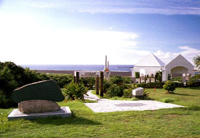Iwo-to Kaitaku no Hi (Iwo-to Cultivation Monument)

Iwo-to is located approximately 280km south of Chichijima, situated at 24 degrees, 47 minutes north latitude and 141 degrees, 19 minutes east longitude. Along with Kita Iwo-to and Minami Iwo-to it constructs the Kazan islands. It had been spotted by a Spanish vessel in the mid-16th century and was referred to as “Vulcano” (volcanic island). It was also discovered by a British expedition team in the late 18th century and was named as Sulfur Island.
Iwo-to became Japanese territory by imperial ordinance in September 1891 and was put under the jurisdiction of the Ogasawara island government of Tokyo. After this the islands were named as Kita Iwo-to (San Alessandro Island), Iwo-to (Sulfur Island), and Minami Iwo-to (San Augustin Island).
Before this in June 1889, Eijiro Tanaka, a resident of Chichijima, left for Iwo-to for the purpose of shark fishing and gathering sulfur along with more than ten people on a sail ship, the Nanyo Maru, which was constructed on Chichijima. This was the beginning of the cultivation of Iwo-to.
Proper sulfur mining business began on the island from 1892. Later on the main industries became farming that made use of the flat land as well as terrestrial heat. The type of crops varied according to the changes with situations on the island, such as sugarcanes, coca leaves, and lemon grasses. The population began to increase along with the flourishing of farming on the island. On April 1940, a municipal organization was enforced on Iwo-to, but Kita Iwo-to remained under direct control of the Ogasawara subprefecture. The population in this year was 1,051 people on Iwo-to and 103 people on Kita Iwo-to. Outbreak of the Pacific War on December 8, 1941. Along with the intensification of the war, the rich and peaceful land became the frontline of defense of the mainland. Residents of the island were forced to evacuate in 1944, and the land of their ancestors became the island of Gyokusai (honorable death). Upon reaching the 100th year after Iwo-to became a territory of Japan, we erect this monument in honor of the achievements of our predecessors who worked to cultivate the island and to entrust their unfulfilled wish of returning to the island.
March 1991, Ogasawara Village